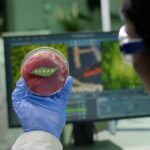The Future of Genetic Engineering — What CRISPR Can Really Do
Genetic engineering has entered a bold new era, and at the center of this revolution is CRISPR, a groundbreaking gene-editing tool that allows scientists to rewrite the code of life with extraordinary precision. Once a futuristic dream, CRISPR technology is now being used to cure diseases, enhance crops, and even reshape evolution itself. But what can CRISPR really do—and how far should humanity go?
What Is Genetic Engineering?
Genetic engineering is the process of modifying an organism’s DNA to alter its traits or functions. Traditionally, this required complex and time-consuming laboratory techniques.
But with the discovery of CRISPR-Cas9 in 2012, genetic modification became faster, cheaper, and far more accurate. CRISPR works like molecular scissors—cutting DNA at precise locations so that scientists can remove, replace, or add specific genes.
This innovation has made gene editing accessible to labs across the world, revolutionizing everything from agriculture to medicine.
How CRISPR Works
At its core, CRISPR uses a guide RNA to find a specific DNA sequence inside a cell. Once it locates the target, an enzyme called Cas9 cuts the DNA. The cell then repairs the cut, often incorporating a new piece of genetic material introduced by scientists.
This mechanism allows:
-
Gene knockout — disabling a faulty gene
-
Gene correction — fixing genetic mutations
-
Gene insertion — adding beneficial traits
Newer versions like CRISPR 3.0 and base editing can modify single letters of DNA without cutting, reducing errors and improving precision.
CRISPR in Medicine: Curing the Incurable
Perhaps the most exciting frontier for CRISPR lies in human medicine. Scientists are already using it to treat—and in some cases, cure—genetic diseases once thought untreatable.
1. Treating Genetic Disorders
CRISPR has shown remarkable success in correcting mutations responsible for diseases such as:
-
Sickle cell anemia
-
Beta thalassemia
-
Cystic fibrosis
-
Muscular dystrophy
In 2023, the first CRISPR-based therapy (Casgevy) for sickle cell disease received regulatory approval, marking a historic milestone in biotechnology.
2. Fighting Cancer
Researchers are engineering immune cells using CRISPR to target and destroy cancer cells more effectively. These modified CAR-T cells are showing promising results in clinical trials for leukemia and lymphoma.
3. Combating Viral Infections
CRISPR is being tested as a weapon against HIV, hepatitis B, and even COVID-19 by directly cutting viral DNA from infected cells. Future CRISPR-based antivirals could eliminate viruses permanently.
CRISPR and Agriculture: Feeding the Future
Beyond medicine, CRISPR is transforming agriculture. Scientists can now create crops that are more resilient, nutritious, and environmentally friendly.
Examples include:
-
Drought-resistant corn and rice
-
Pest-resistant tomatoes and soybeans
-
Nutrient-enriched wheat and cassava
These advances could help fight world hunger and reduce dependence on chemical fertilizers and pesticides. Unlike traditional GMOs, CRISPR-edited crops are more precise and often indistinguishable from naturally bred varieties.
CRISPR and Animal Engineering
In animal biotechnology, CRISPR is used to improve livestock health, increase productivity, and model human diseases for research.
Some remarkable examples:
-
Pigs genetically modified to produce organs suitable for human transplants
-
Mosquitoes edited to eliminate malaria transmission
-
Cows engineered to resist infections like bovine tuberculosis
While these achievements hold great promise, they also raise deep ethical questions about human interference with nature.
The Ethics of Genetic Engineering
With great power comes great responsibility. The ability to modify human DNA brings both hope and fear.
Key ethical debates include:
-
Germline editing – Should we alter the DNA of embryos, passing changes to future generations?
-
Designer babies – Is it ethical to edit genes for intelligence, height, or appearance?
-
Equity and access – Will genetic advancements be available to all, or only to the wealthy?
In 2018, a controversial case in China—where a scientist edited the genes of twin babies—sparked global outrage and led to tighter regulations. Many countries now ban or strictly limit human germline editing.
CRISPR Beyond Humans: Environmental and Evolutionary Impact
CRISPR has enormous potential in conservation biology and ecosystem management. Scientists are exploring ways to:
-
Revive extinct species like the woolly mammoth
-
Control invasive species threatening biodiversity
-
Save endangered animals through genetic rescue
However, editing ecosystems carries unpredictable risks, including potential imbalances in food chains and genetic pollution.
The Next Generation: CRISPR 3.0 and Beyond
The future of genetic engineering is moving toward safer, more sophisticated CRISPR systems:
-
Prime Editing: Edits DNA with “find-and-replace” accuracy, minimizing errors.
-
Epigenetic Editing: Alters gene expression without changing DNA sequences.
-
RNA Editing: Temporarily modifies RNA to treat diseases without permanent genetic changes.
These advances could lead to universal gene therapies—treatments that correct multiple conditions using a single system.
Challenges and Limitations
Despite its promise, CRISPR still faces hurdles:
-
Off-target effects – unintended DNA edits can cause harmful mutations.
-
Delivery issues – getting CRISPR safely into the right cells is complex.
-
Regulatory barriers – strict laws slow down clinical use.
Continuous research is addressing these challenges, making CRISPR safer and more reliable each year.
The Future Vision: A Genetically Smarter World
By 2030, CRISPR could enable:
-
Personalized genetic therapies for every individual
-
Disease-resistant humans and animals
-
Sustainable agriculture that feeds 10 billion people
-
Eradication of hereditary disorders from the human gene pool
The line between science fiction and reality is blurring fast. As CRISPR continues to evolve, so too must our understanding of its potential—and its limits.
Conclusion
The future of genetic engineering is bright, bold, and full of possibilities. CRISPR technology stands at the heart of this transformation, giving humanity the power to cure diseases, reshape evolution, and protect the planet.
But with such power comes the responsibility to use it wisely. The decisions made today will determine not only the future of medicine and agriculture—but the future of life itself.











